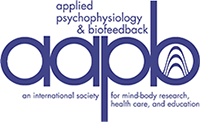Integrating Heart Rate Variability Biofeedback into Mindfulness-Based Therapies
Practitioners using heart rate variability biofeedback (HRVB) often must supplement the biofeedback training with other therapeutic techniques. In this article, I describe some of the ways in which my interns and I integrate a mindfulness-based therapy called ACT (acceptance and commitment therapy) into our biofeedback based clinical protocols. I describe some aspects of the HRVB, provide a short overview of ACT, and discuss how they can be combined.

A typical screen shot demonstrating mastery of heart rate variability biofeedback. We look for symmetry between the respiration wave (in blue above) and the heart rate waveform (in red), maximum peak/valley amplitude, and maximum low frequency peak (in green). Positive indicators are the rising temperature and lowered skin conductance (blue and purple) in the lower right hand panel.

The Six Core Principles of ACT (Harris, 2008, pp. 33–34).

Richard Gevirtz
Contributor Notes
